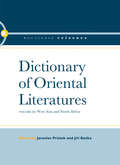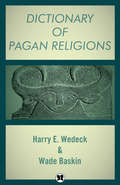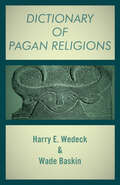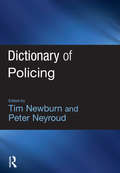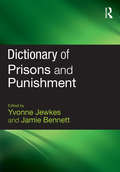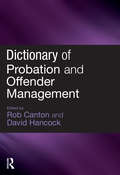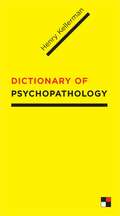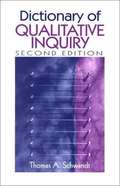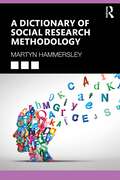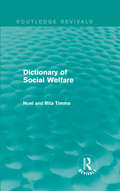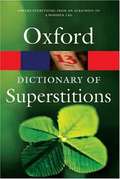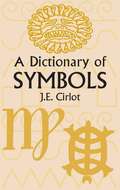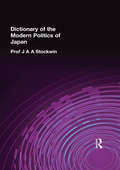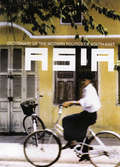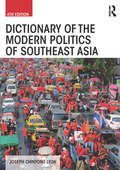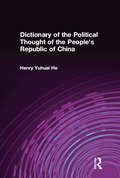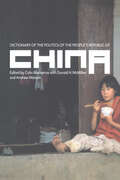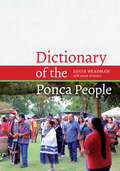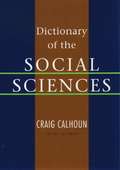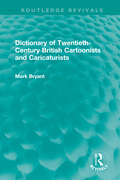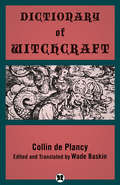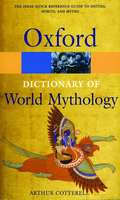- Table View
- List View
Dictionary of Oriental Literatures 3: West Asia and North Africa
by Jaroslav Průšek Jirí BeckaThe Dictionary of Oriental Literatures fills a long-felt gap in Western literature by presenting a concise summary, in three volumes and about 2000 articles, of practically all the literatures of Asia and North Africa. The first volume describes the Chinese, Tibetan, Japanese, Korean and Mongolian literatures; the second covers the area of South and South-East Asia, comprising, besides all literatures of India and Pakistan, those of Nepal, Bangladesh, Sri Lanka, Myanmar, Thailand, Cambodia, Vietnam, Indonesia, Malaysia and the Philippines; and the third is devoted to the numerous literatures of West Asia and North Africa. including on the one hand the literatures of the ancient Near East and Egypt, and on the other hand those of Central Asia and the Caucasus, of Turkey, Iran, Afghanistan and of the various Arab countries including Morocco, Tunisia and Algeria. The majority of entries give information about the life and work of the individual writers and poets of the classical, medieval and modern periods of the literatures included and also attempt to evaluate their writings from the historical and aesthetic point of view. The remaining articles describe literary terms, genres, forms, schools, movements etc. The Dictionary has been prepared by the Oriental Institute in Prague under the supervision of a Advisory Editorial Board of European and American scholars of international reputation and is unique in that it is the fruit of the collaboration of over 150 orientalists from many parts of the world. Contents include: Volume I East Asia: The Far East, including Chinese, Tibetan, Japanese, Korean and Mongolian literatures. Volume II South and South-East Asia: Ancient Indian, Assamese, Baluchi, Bengali, Gujarati, Hindi, Indian literature in English, Indo-Persian, Kannada, Kashmiri, Maithili, Malayalam, Marathi, Oriya, Panjabi, Pashto, Rajasthani, Sindhi, Tamil, Telugu and Urdu, Sinhalese, Nepali, Burmese, Thai, Cambodian, Malay and Indonesian, Javanese, Vietnamese and Philippines literatures. Volume III West Asia and North Africa: The Near East and Egypt, Central Asia and the Caucasus, Turkish, Persian, Afghan, Kurd and Arabic literatures, covering all the Arab states from Iraq in the East to Algeria in the West.
Dictionary of Pagan Religions
by Wade Baskin Harry E WedeckAssembled here for the first time in one volume are the essential facts about the cults, rites and rituals associated with polytheistic religions that have existed from the Stone Age to the present. The aim of the book is to create and preserve a partial record of the pagan religions or cults that have flourished since the dawn of mankind and of their impact and influence throughout the world. This record includes many of the forgotten religions and their ideologies, practices, and mythologies.
Dictionary of Pagan Religions: Dictionary Of Satanism, Dictionary Of Witchcraft, And Dictionary Of Pagan Religions
by Harry E. Wedeck Wade BaskinA comprehensive reference guide to religious cults of the ancient world, with essential information on religious systems, texts, temple sites, and more. Dictionary of Pagan Religions offers a wide-ranging survey of the many religious cults that have flourished around the world from the Stone Age to the present. From Egyptian to Celtic traditions, and Gnosticism to Cabala, coauthors Harry E. Wedeck and Wade Baskin have compiled in-depth information about the rites and rituals associated with these religious systems, as well as their surprisingly significant influence on mainstream theology and philosophy. This authoritative text includes many of the world&’s forgotten religions, with important information about their ideologies, practices, mythologies, and more. Arranged in A-to-Z format, Dictionary of Pagan Religions is an essential reference guide for any student of paganism, polytheism, or ancient religious practices.
Dictionary of Policing
by Tim Newburn Peter NeyroudContemporary policing is developing rapidly and is becoming increasingly professionalized. For practitioners National Occupational Standards, Skills for Justice and the the new PDLP (Police Development and Leaning Programme) have brought a new emphasis on skills, standards and knowledge. Training for police officers and civilian staff working in policing is being significantly upgraded. At the same time it has become more rigorous, with universities and other higher educational institutions playing an increasingly important part in police training - as well as expanding the range of policing courses for undergraduate and postgraduate students.Key features: approximately 300 entries (of between 500 and 1500 words) on key terms and concepts arranged alphabetically designed to meet the needs of both students and practitioners entries include summary definition, main text and key texts and sources takes full account of emerging occupational and Skills for Justice criteria edited by the UK's leading academic expert on policing and the Chief Executive of the National Policing Improvement Agency Entries contributed by leading academic and practitioners in policing
Dictionary of Prisons and Punishment
by Yvonne Jewkes Jamie BennettContemporary prison practice faces many challenges, is developing rapidly and is become increasingly professionalized, influenced by the new National Offender Management Service. As well as bringing an increased emphasis on skills and qualifications it has also introduced a new set of ideas and concepts into the established prisons and penal lexicon. At the same time courses on prisons and penology remain important components of criminology and criminal justice degree courses. This will be the essential source of reference for the increasing number of people studying in, working in prisons and working with prisoners. This Dictionary is part a new series of dictionaries covering key aspects of criminal justice and the criminal justice system and designed to meet the needs of both students and practitioners: approximately 300 entries (of between 500 and 1500 words) on key terms and concepts arranged alphabetically designed to meet the needs of both students and practitioners entries include summary definition, main text and key texts and sources takes full account of emerging occupational and Skills for Justice criteria edited by a leading academic and practitioner in the prisons and penology field entries contributed by leading academic and practitioners in prisons and penology.
Dictionary of Probation and Offender Management
by Rob Canton David HancockContemporary probation practice is developing rapidly and is become increasingly professionalized. Probation officers are typically described now as offender managers, and the creation of NOMS (National Offender Management Service) has broadened the remit of the Probation Service. As well as bringing an increased emphasis on skills and qualifications it has also introduced a new set of ideas and concepts into the established probation lexicon - including institutional, legal, political and theoretical terms of its own as well as importing concepts from the disciplines of sociology, criminology and psychology. This Dictionary is the essential reference book. This Dictionary is part a new series of Dictionaries covering key aspects of criminal justice and the criminal justice system and designed to meet the needs of both students and practitioners: approximately 300 entries (of between 500 and 1500 words) on key terms and concepts arranged alphabetically designed to meet the needs of both students and practitioners entries include summary definition, main text and key texts and sources takes full account of emerging occupational and Skills for Justice criteria edited by a leading academic and practitioner in the probation and offender management field entries contributed by leading academic and practitioners in probation and offender management.
Dictionary of Psychopathology
by Henry KellermanPsychologists, psychiatrists, social workers, psychiatric nurses, theoreticians, practitioners, and other allied professionals who together represent the entire arc of the mental health field must be versed in psychopathology, the study of mental and emotional phenomena, abnormal psychology, and specific symptoms and behaviors. Building a reference that speaks to all of these professions and subjects, Henry Kellerman assembles the first dictionary to focus exclusively on psychopathology, featuring more than two thousand entries (over fifteen hundred primary and more than five hundred subentries) on specific symptoms and disorders, general syndromes, facets of personality structure, and diagnosis. He also includes a sampling of benchmark contributions by theoreticians and researchers that cover the history of psychopathology. These contributions reflect those of a psychodynamic nature as well as cognitive and behavioral approaches, and represent the relatively new field of neuropsychoanalysis as well. This branch of neuroscience is concerned with the relation between the brain and the mind, specifically with reference to brain architecture and function. Monitored by a distinguished editorial board, the Dictionary of Psychopathology mostly adheres to the latest DSM nomenclature while also retaining useful residual diagnoses of previous DSM formulations, as well as diagnostic formulations outside of traditional nosologies. The aim of the Dictionary is to broadly contribute to the synthesis of psychopathology.
Dictionary of Qualitative Inquiry
by Thomas A. SchwandtSchwandt provides description and references for many terms used in qualitative inquiry.
Dictionary of Satanism
by Wade BaskinA handy, comprehensive guide to a wide range of topics relating to the awesome power and cult of Satan, in myriad forms and under many different names, from ancient times to the present. Distilled from hundreds of reliable sources, both religious and secular, the entries include men and movements, orders and objects, rites, rituals, incantations, events, legends, and occult practices that have fascinated the mind of man through the ages. It also contains entries relating to a host of unorthodox beliefs and irrational acts, such as the murder of Sharon Tate, which have only recently come to light. The simple manner in which even the most abstruse topics are handled is certain to open the mysterious world of darkness to readers with no prior knowledge of the occult and to intrigue and inform those who seek to extend their knowledge of the subject.
A Dictionary of Social Research Methodology
by Martyn HammersleyThis accessible book offers a detailed guide to a wide range of methodological concepts, both those of a philosophical kind and those that are more technical in character: from constructionism to critical realism, grounded theory to regression analysis, odds ratios to triangulation.It covers quantitative, qualitative, and mixed methods research. There are shorter entries for relatively straightforward terms and longer entries for terms that are more complex or carry more than one meaning. The book includes basic terms – such as data, empirical, fact, meaning, theory, and truth – as well as those that highlight major contemporary trends in the field, such as arts-based research, indigenous methodologies, and decolonisation. It is therefore relevant to many methodological issues and controversies taught in social science degree programmes today.Providing clear definitions for a wide range of methodological concepts from across the social sciences, this is an essential resource for all who have an interest in social research methodology.
Dictionary of Social Welfare
by Noel W Timms Rita TimmsFirst published in 1982, this dictionary offers a practical aid to students of social work and of social policy in their conversation about social welfare. It explains the meaning or range of meanings of common terms and explains their applications in welfare, legislation, policy and use by welfare practitioners. It helpfully cross-references terms with similar or related terms that might be considered alongside. In addition, most entries are concluded by references which introduce the reader to a more extended treatment of the term or an elaboration of its application in the language of social welfare. Although first published in 1989, this book will be a valuable resource for students of social work, social policy and social welfare.
Dictionary of Statistics & Methodology: A Nontechnical Guide for the Social Sciences
by W. Paul VogtThis reference provides definitions of commonly used statistical terms in easily-understood language.
A Dictionary of Superstitions
by Iona Opie Moira Tatem EditorsThe vast subject of 'superstitions', taken by us to include divinations, spells, cures, charms, signs and omens, rituals, and taboos, has never before been systematically organized. In this dictionary the editors have assembled chiefly those superstitions from Great Britain and Eire which survived into the nineteenth and twentieth centuries, with a preponderance of the everyday, domestic beliefs with which most readers will be familiar. They have been arranged alphabetically according to their central idea or object, and illustrated with a selection of quotations chronologically ordered to show the history and development of each belief. The quotations are from a wide range of sources: diaries, letters, local histories and glossaries, works of literature, folklore publications, journals, and newspapers.
A Dictionary of Symbols (Dover Occult Ser.)
by J. E. CirlotHumans, it's said, are symbolizing animals. At every stage of civilization, people have relied on symbolic expression, and advances in science and technology have only increased our dependence on symbols. The language of symbols is considered a science, and this informative volume offers an indispensable tool in the study of symbology. It can be used as a reference or simply browsed for pleasure. Many of its entries — those on architecture, mandala, numbers, serpent, water, and zodiac, for example — can be read as independent essays. The vitality of symbology has never been greater: An essential part of the ancient arts of the Orient and of the Western medieval traditions, symbolism underwent a 20th-century revival with the study of the unconscious, both directly in the field of dreams, visions, and psychoanalysis, and indirectly in art and poetry. A wide audience awaits the assistance of this dictionary in elucidating the symbolic worlds encountered in both the arts and the history of ideas.
Dictionary of the Modern Politics of Japan
by Prof J Stockwin J. A. StockwinThe politics of Japan are less widely reported than its economics. Most people are aware of the economic 'miracle' following the Second World War, whereby Japan became the second largest economy in the world after the United States, and the economic stagnation of the early 1990s is also well known. But it is difficult to make sense of these phenomena without a knowledge of the political system and the ways in which it works in practice. Containing an introductory essay, an essay on theories of Japanese politics and over 250 A-Z entries, the Dictionary of the Modern Politics of Japan remedies this imbalance, and answers the need for an accessible work of reference bringing together information and authoritative analysis on all aspects of the politics of Japan and the Japanese political system.Including a fully annotated bibliography to guide the user to further reading, the entries are thoroughly cross-referenced and indexed, and are supplemented with maps and tables, to ensure that the Dictionary of the Modern Politics of Japan is essential reading for all scholars and students of the politics and international relations of Japan.
Dictionary of the Modern Politics of Southeast Asia
by Michael LeiferThis comprehensive Dictionary provides descriptive and analytical coverage of the turbulent political history and striking changes which have occurred both regionally and in key countries since the end of the Second World War. Substantially rewritten to take into account the dramatic political events and developments since 1995, the third edition of this acclaimed Dictionary will provide non-specialists and specialists alike with an essential resource on this constantly changing and volatile region.Including new entries, updated country profiles on Indonesia, Malaysia and Cambodia and a revised reading list, leading authority and commentator on this rapidly developing region Michael Leifer has brought this Dictionary fully up-to-date. Changes in government, the rise of new leaders and the knock-on effect on economy and society are covered including: the death of key figures such as Pol Pot and the rise of a new generation of leaders, dramatic changes of government in Indonesia, Thailand and the Philippines and elections in Malaysia.Countries covered include Brunei, Burma (Myanmar),Cambodia (Kampuchea), Indonesia, Laos, Malaysia, the Philippines, Singapore, Thailand and Vietnam.Key features include:* Individual entries provide detailed information and authoritative commentary on the central figures, political parties and organizations, political systems and structures, major events and key documents.* For each state covered, an extended narrative analyses its recent history and political and social development.* Extensive cross-referencing and a subject index lead the reader to the vital material.* Subject bibliographies refer researchers to source and secondary matter.
Dictionary of the Modern Politics of Southeast Asia (Politics in Asia)
by Joseph Chinyong LiowThe past three decades since the end of the Cold War have been a time of remarkable change for Southeast Asia. Long seen as an arena for superpower rivalry, Southeast Asia is increasingly coming into its own by locating itself at the forefront of regional integration initiatives that involve not only the states of the region, but major external powers such as the United States, China, India, Japan, and Australia. Extensively updated and revised in light of these changes and developments, this fifth edition of Dictionary of the Modern Politics of Southeast Asia remains indispensable. This new edition starts with profiles of each Southeast Asian country, before providing over 500 alphabetically arranged individual entries, each containing detailed accounts and analyses of major episodes and treaties, political parties and institutions, civil society movements, and regional and international organizations. Biographies of significant political leaders and personalities, both past and present, are also provided. Entries are comprehensively cross-referenced, and an index by country directs readers to all entries concerning a particular country. The Dictionary concludes with an extensive bibliography that serves as a guide to further reading. An essential one-stop reference book, this book is an indispensable tool for all scholars and students of Asian politics and international affairs, and a vital resource for journalists, diplomats, policy makers, and others with an interest in the region.
Dictionary of the Modern Politics of Southeast Asia
by Joseph Liow Michael LeiferThe past two decades since the end of the Cold War have been years of remarkable change and transformation for Southeast Asia. Long seen as an arena for superpower rivalry, Southeast Asia is increasingly coming into its own by locating itself at the forefront of regional integration initiatives that involve not only the Association of Southeast Asian Nations, but major external powers such as the United States, China, India, Japan, and Australia as well. At the same time, the past two decades has seen the revival of old animosities as well as the emergence of new security challenges confronting the region. Old animosities include unresolved territorial disputes, while new challenges range from regional and global financial crises, terrorism, and pandemics. Significant changes within the ten Southeast Asian countries covered in this book have also transpired that have affected not only the complexion of domestic politics, but have also impacted regional diplomacy as well, such as the creation of potentially the eleventh "Southeast Asian" country – Timor Leste. Extensively updated and revised in light of these changes and developments, this fourth edition of Dictionary of the Modern Politics of Southeast Asia contains profiles of each Southeast Asian country. Following this, it provides more than 450 alphabetically arranged individual entries providing detailed accounts and analyses on major episodes and treaties, political parties and institutions, civil society movements, and regional and international organizations. Biographies of significant political leaders and personalities, both past and present, are also provided. Entries are comprehensively cross-referenced, and an index by country directs readers to all entries concerning a particular country. The Dictionary also includes an extensive bibliography that serves as a guide to further reading. It is an essential reference tool for all scholars and students of Asian politics and international affairs, and a vital resource for journalists, diplomats, policy-makers, and others with an interest in the region.
Dictionary of the Political Thought of the People's Republic of China
by Henry Yuhuai HeFar more than a simple glossary, this unique resource provides a detailed lexicography of political and social life in China today, and deepens our understanding of the last twenty years of enormous change in the People's Republic. Each of the 1,600 entries (1) is rendered in Chinese characters; (2) is alphabetized according to pinyin, the Chinese phonetic alphabet; (3) is translated into English; and (4) is explained in terms of the situation in which it first appeared and how its meaning shifted over time. In addition to the main body of definitions and annotations, there are three appendices, abbreviations, a name index, and a bibliography.
Dictionary of the Politics of the People's Republic of China
by Andrew Watson Colin Mackerras Donald H. McMillenAs China's political and economic development comes under closer scrutiny, this Dictionary will prove invaluable to anyone with an interest in contemporary China. As well as proving valuable to students and academics of political science, economics, history and Asian studies, it will be of use to government officials, business people and media professionals with current or future connections in the region. The main topics covered by the Dictionary are:* major political processes and events * key issues in domestic policy* China's evolving foreign policy environment* key political personalities* major political institutions and groupings* important aspects of the legal system.
Dictionary of the Ponca People
by Louis V. Headman Sean O'NeillPublished through the Recovering Languages and Literacies of the Americas initiative, supported by the Andrew W. Mellon Foundation. Dictionary of the Ponca People presents approximately five thousand words and definitions used by Ponca speakers from the late nineteenth century to the present. Until relatively recently, the Ponca language had been passed down solely as part of an oral tradition in which children learned the language at home by listening to their elders. Almost every family on the southern Ponca reservation in Oklahoma spoke the language fluently until the 1940s, when English began to replace the Ponca language as children entered government boarding schools and were forced to learn English. In response to demand, Ponca language classes are now being offered to children and adults as people seek to gain knowledge of this important link to tradition and culture. The approximately five thousand words in this volume encompass the main artery of the language heard and spoken by the parents and grandparents of the Ponca Council of Elders. Additional words are included, such as those related to modern devices and technology. This dictionary has been compiled at a time when the southern Poncas are initiating a new syntactic structure to the language, as few can speak a full sentence. This dictionary is not intended to recover a cultural period or practice but rather as a reference to the spoken language of the people.
Dictionary of the Social Sciences
by Craig CalhounWith coverage on the vocabularies of anthropology, sociology, political science, economics, human geography, cultural studies, and Marxism, the Dictionary is an integrated, easy-to-use, A-to-Z reference tool.
Dictionary of Twentieth-Century British Cartoonists and Caricaturists (Routledge Revivals)
by Mark BryantBritish cartoonists and caricaturists are renowned worldwide. Originally published in 2000, this indispensable handbook offers a unique ‘who’s who’ of all the major artists working in Britain in the twentieth century and contains nearly 500 entries. Extensively illustrated, the book provides information on the work of artists such as Steve Bell, Gerald Scarfe, Posy Simmonds, Ronald Searle, Trog, mac and Larry as well as such past masters as David Low, Vicky, H. M. Bateman, Illingworth, Heath Robinson and more. The dictionary concentrates primarily on political cartoonists, caricaturists and joke or ‘gag’ cartoonists, actively working for the main Fleet Street national dailies and weeklies from 1900 to 1995. Each entry is cross-referenced and provides a concise biographical outline with an account of the artist’s style, influences and preferred medium. Where relevant the entry includes suggestions for further reading and notes solo exhibitions, books illustrated and works held in public collections. The Dictionary of Twentieth-Century British Cartoonists and Caricaturists offers an insight into the lives of satirical artists working during a century that provoked cartoonists and caricaturists to a pitch of comic and artistic invention that has rarely been matched.
Dictionary of Witchcraft
by Wade Baskin Collin De PlancyDictionary of Witchcraft is a must-have resource for anyone interested in witchcraft, pagan religions, and the occult. This historical dictionary was the first reference work to seriously document superstitions, manifestations, magic, and superstitions. The author's interest was to compile a vast amount of matter that would interest, entertain and instruct others. This dictionary was consulted by some of the greatest Romantic writers, notably by Hugo. Collin de Plancy followed the tradition of many previous demonologists of cataloguing demons by name and title of nobility, as it happened with grimoires like Pseudomonarchia Daemonum and The Lesser Key of Solomon among others. It is considered a major work documenting beings, characters, books, deeds, and causes which pertain to the manifestations and magic of trafficking with Hell; divinations, occult sciences, grimoires, marvels, errors, prejudices, traditions, folktales, the various superstitions, and generally all manner of marvelous, surprising, mysterious, and supernatural beliefs.
A Dictionary of World Mythology
by Arthur CotterellRecent interest in mythology indicates a general recognition of the power of the poetical tales. But there is still a fair measure of disagreement as to what is the strength of myths. For Plato, the first known user of the term, mythologia meant no more than the telling of stories which usually contained legendary figures. Another theory of origin is that folklore and mythology are almost indistinguishable. In the arrangement of this book can be discerned the seven great traditions of world mythology: namely, West Asia, South and Central Asia, East Asia, Europe, America, Africa, and Oceania.
